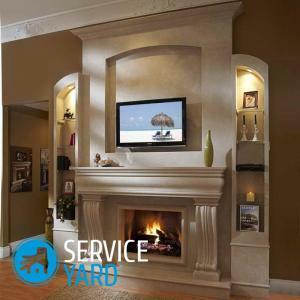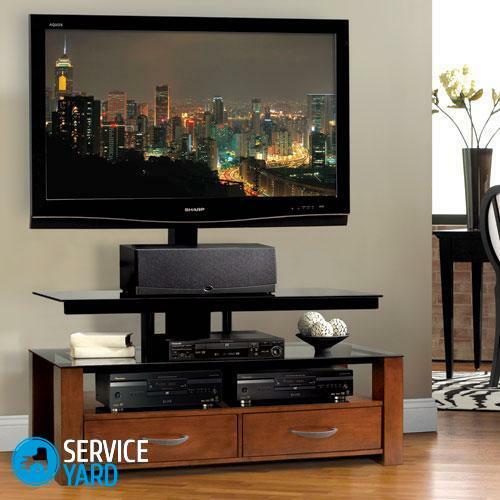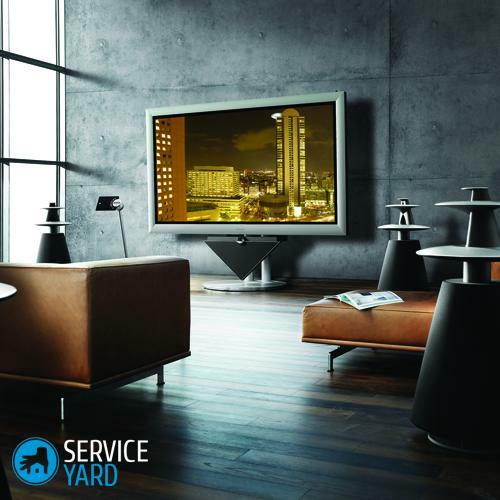
- Diagonal TV - which is better?
- How to choose the right diagonal?
- Dependence of viewing angle and screen size
- Tips for choosing a TV
- Other TV options
A modern house, an apartment, you can not imagine without a TV set with an impressive diagonal size. But during the purchase, or better - before it is committed, you need to decide for yourself which diagonal of TV you need. What technologies and functions should be present in your home technology? With all these questions, we'll help you figure it out.
to the contents ↑Diagonal of the TV - which is better?
A common opinion as to which diagonal screen TV is better, simply does not exist. When choosing household appliances with certain parameters it is necessary to take into account your own preferences, the area of the room in which your new TV will be located.
Important! The smallest distance from which it is allowed to watch TV programs is approximately 1.5 meters. And given the size of the room for installation and it turns out that for each specific customer has its own ideal diagonal of the TV.
A significant role is played by your individual characteristics, namely: visual acuity, as well as your own perception of the image. Also it is necessary to take into account that the eyes get tired as well as with a large screen, if the image quality is lost, and with small ones, provided the distance is too large. Therefore, everything must be proportionate.
to the contents ↑How to choose the right diagonal?
We omit those cases when there is practically no choice due to stringent financial constraints or, if a place with certain dimensions is prepared in advance for the technique. In order to calculate the required distance for viewing the image, we give the calculation formulas by which you can easily calculate the correct distance for viewing.
For the image format DVD-720h576
In this case, do this calculation: the diagonal of the TV screen in centimeters multiply by 4.15.
This is the distance from which you can watch programs on the technology with this image quality.

Important! To convert inches to centimeters, multiply inches by 2.54.Distance values for popular models:
- 1,5-2 m - for 19 ";
- 2,4-3,4 m - for 32 ";
- 3-4.2 m - for the indicator in 40 ".
For HD-1280x720 format image
In this case, the following formula is used: the diagonal of the TV in centimeters is multiplied by 2.35.
Important! The average values for the most popular models are:
- 1.13 m - for 19 ";
- 1,9 m - for 32 ";
- 2.38 m - for 40 ".
For the image format Full HD-1920x1080
The calculation formula for this screen looks like this: the diagonal of the TV in inches is multiplied by 1.56.In general, it is enough to allocate a minimum of 0.87 m when installing a 19 "screen, 1.27 m for a 32-inch panel, 1.59 m for a 40-inch screen.
Important! In addition to the size of the image panel, it is necessary to take into account the signal quality that the provider will provide, as well as the resolution of the picture. The higher the metric, the closer you can view the transmissions without sacrificing image quality. And vice versa.
to content ↑Dependence of viewing angle and screen size
Such great attention is paid to the diagonal of the TV, its resolution, as well as the viewing distance because these parameters greatly influence the effect of the presence of the viewer.
This effect affects how much you are immersed in everything that is happening on the screen. Here, peripheral vision also has its significance, the work of which depends directly on the angle at which you look at the image.
Correct viewing angle
Different sources recommend different angles of video viewing on the screen for a greater immersion in the reality of cinematography.
For HDTV models, there is a recommendation for viewing angles, in which three values are indicated:
- 20 ° - at this viewing angle the distance is diagonal x 2.5.
- 30 ° - at this angle the distance is diagonal x 1.6.This viewing angle is especially popular for home theaters.
- 40 °.TCN recommends choosing a distance that is diagonal x 1.2.This is the minimum viewing distance of Full HD TVs.
Important! When buying household appliances for classical use, and not for a home theater system, it is necessary to take into account, in addition to the immersion effect, other features. They are related to the limitations when installing a TV set. That's why the optimal distance, as well as the diagonal of the TV, is associated with other values.
The right choice for the location of the
Depending on whether you decide to buy a TV for a bedroom, living room, kitchen or another room, the preferred diagonal will also change. For example:
- if you decide to place the equipment in a kitchen in the middle of the wall or on a bar counter, a small screen is preferable - about 19-22 inches;
- for a spacious living room will suit a wide format model from 40 to 75 inches, so that from different angles of the room every member of the family or guest could enjoy watching a quality picture.
Tips for choosing a TV
To understand not only what kind of diagonal TV you need, but in general with the functionality of the equipment, we suggest to take into account such factors in the purchase process.
Choose the right screen size
The screen diagonal depends on the size of the room in your home where the TV will be.
There are unspoken rules, such as: the distance to the screen is equal to three diagonals of the panel. But they should not follow, as each person has his own angle of view, as well as his perception of the film image.
The most effective way to test your individual angle of view is to ask your friends for a projector and experiment. Change the focal length of the projector lens by comparing the picture quality.

Important! Remember that there is a minimum allowable border of the sizes of a diagonal for a house cinema. This border lies in the area from 26-27 inches, because from these diagonals begin the matrix, which supports HD - high-clear image.
Choose the technology of
that is right for you. It's extremely important to choose the technology of your future TV precisely because any of them has its pluses and minuses. Here is a short list of technologies that are used in the assembly of modern generation models.
CRT or kinescope
This is the oldest of the existing ones. In fact, this is a simple, familiar to us, TV:
- The single-valued advantages of this technology - a stable long working capacity, on the diagonals of the TV to 30 inches is a pretty good picture.
- Cons - there is no support for HDTV, large dimensions of technology and weight.
LCD or LCD
Sufficiently young technology, which features such features:
- Pros - a flat panel, support for high-definition images, the dimensions of the HD-matrix can be small diagonals, even up to 19 inches.
- Cons - a fairly low response speed, as well as a limited viewing angle. But these disadvantages are no longer a "disease" for this technology, although the picture on the LCD TV is still different. It differs a little contrast, as well as the rigidity of the picture.
Plasma
In England is called PDP.This is the very first of the technology of flat panels. What can you expect when buying such equipment:
- Pros - no other technology, for now, does not give such a large and tangible image contrast as a plasma panel. It gives the picture a natural image, color brightness, and softness of sound.
- Cons - manufacturers have long and fairly successfully struggling to extend the shelf life of the plasma panel and burn out its individual sections. Another disadvantage of the plasma panel is that the diagonal of the TV is less than 50 inches can not support Full HD images.
Projection technology
This kind of equipment is divided into 3 main groups: LCD, DLP, D-ILA.Here is a general characteristic of their properties:
- Pros - soft picture, high definition, brightness, contrast.
- Minus one, but still it's minus - one viewing angle, vertically very limited.
Other variants of TVs
In addition to the main type and type of matrix or device, the manufacturer includes additional names in the characteristics of its products. What can they tell you about?
Active Crystal Color( Samsung)
There is Active Crystal Color technology on TVs and Samsung monitors. This technology is designed to improve the quality of the image on the device screen by optimizing various algorithms of the system.
So far, this technology is only used in TVs that have displays on quantum dots, as well as monitors with screens that are manufactured using VA technology.
The quality of the transmitted color in the image depends on the quality of the TV screen, and only after - on the software and processing algorithms.
Important! Given the fact that this technology is used mainly on monitors with a new matrix, it can be assumed that such a name pursues the marketing task of attracting and drawing the buyer's attention to details in the description of a certain device.
What is Ultra Color Spectrum ™ on Vizio TVs?
Vizio TVs are mainly sold in the US.Premium TVs support the new Ultra Color Spectrum ™ technology, which is designed to optimize the tonal range and contrast of the screen color.
Its presence in this TV depends only on the quality of the screen panel, because the TV processor processes the received digital images in exactly the same way.
Important! Regardless of the model and the diagonal of the TV, it is possible to achieve a qualitative change in the image only if the screen is improved.
In televisions with Ultra Color Spectrum technology, only improved screens are used. Effectiveness is mainly concerned only with the presence of local dimming, since the backlight LEDs are broken into certain zones. This allows you to automatically turn off the screen backlight in dark scenes.
Now you have a little idea of what kind of diagonals TVs can be.



